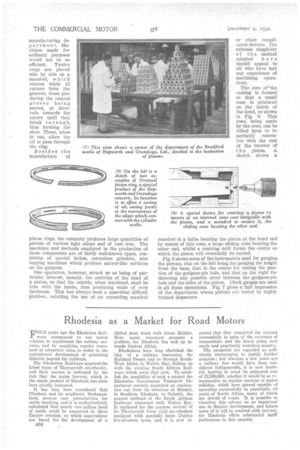Rhodesia as a Market for Road Motors
Page 48

If you've noticed an error in this article please click here to report it so we can fix it.
FOUR years ago the Rhodesian Railways commenced to run motor vehicles to supplement the railway services, and by supplying regular transport at attractive rates to assist in the agricultural development of promising districts beyond the railways.
The Rhodesian Railways acquired the latest types of Thornycroft six-wheeler, and their success is indicated by the fact that the maize harvest, which is the staple product of Rhodesia, has since been greatly increased.
It has long been considered that Rhodesia and its neighbour, Bechuanaland, possess vast potentialities for cattle ranching, and it is authoritatively calculated that nearly two million head of cattle could be supported in these. Empire colonies, on which expectations are based for the development of a
ya34
chilled meat trade with Great Britain. Here again transport presents a problem, for Rhodesia lies well up towards Central Africa.
Rhodesians have long cherished the idea of a railway traversing the Kalahari Desert and on through SouthWest Africa to Walvis Bay, linking up with the existing South African Railways which serve that port. To establish the possibility of such a project the Rhodesian Government Transport Department recently organized an exploration run from its terminus at Matetsi, in Southern Rhodesia, to Gohabis, the nearest railhead of the South African Railways connected with Walvis Bay. It employed for the purpose several of its Thornyeroft 3-ton rigid six-wheelers equipped with specially large Dunlop low-pressure tyres, and it is now re ported that they completed the journey successfully in spite a the extremes of temperature and the heavy going over sandy and practically waterless country.
The prospects are regarded as sufficiently encouraging to justify further progress; but whereas a few years ago a railway line would have been considered indispensable, it is now doubtful, bearing in mind its estimated cost of £2,500,000, whether it would he so remunerative as regular services of motor vehicles, which have proved capable of operating successfully in practically all parts of South Africa, many of which are devoid of roads. It is possible to visualize this scheme as an important one in Empire development, and future news of it will be awaited with interest, for Rhodesia offers substantial tariff preferences to this country.




























































































